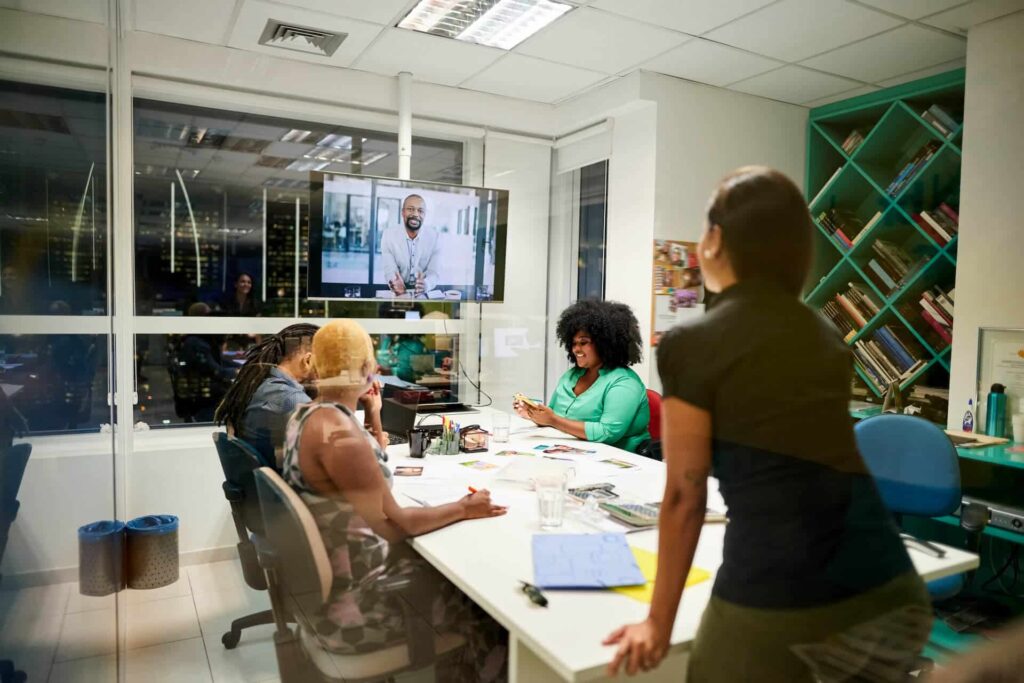Workplace transformation: 6 data-driven best practices for hybrid

Workplace transformation: some companies want it, some companies need it, but no company can accomplish it without the right strategy, tools, and data.
In this article, we explore workplace transformation. We cover six best practices and how to use the right data to change your workplace for the better.
Workplace strategies today are increasingly complex, requiring companies to continuously evolve if they want to stay competitive. While we’re focusing primarily on creating (or optimizing) a remote-first or fully hybrid workplace, companies can use the following strategies to help support change management for a variety of workplace transformations.
Do you need a workplace transformation?
Are you ready for the future of work? Is your workplace?
It might sound like a buzzword, but don’t let that fool you. Workplace transformation is something that should be top of mind for every company as we move into our ‘new normal.’
Digital and workplace transformation is just what it sounds like. Revamping processes, physical workspaces, and workplace technology to create a company culture and working environment that is more in line with business goals. Ideally, this will lead to gains for employees, too.
This type of transformation is especially critical for any company planning to continue with any amount of remote and/or hybrid work post-pandemic. This will likely be the majority of companies that are able to do so. It’s predicted that 75% of companies that embrace a hybrid work model will see a 25% faster growth rate than their competitors. And that up to 83% of employees want to continue working this way indefinitely.
Hybrid and digital workplace solutions
Given these numbers, it’s safe to assume that the majority of companies will continue experimenting with a hybrid schedule. And will therefore require new physical and digital workplace solutions to keep up.
Meanwhile, researchers stress that implementing permanent hybrid work will require ‘active digital transformation in the workplace.’
And like others share in Frontiers in Psychology, “digital transformation is a process of deep, structural change that occurs through the integration of multiple technologies and fundamentally redefines organizational value and identity.”
In short, if you plan to implement any amount of long term hybrid and/or remote work, and if you currently have a more traditional workplace (or one with only a small amount of current flexible seating), then you need a workplace transformation.
Companies need new ways to create a better place for everyone based on their culture, operations and comfort level.
David Cocchiara, OfficeSpace Software CEO, Forbes
Adaptability matters more than ever
Any number of factors can be complicating your workplace today:
- The challenges of supporting remote workers
- The challenges of hybrid working
- Social distancing and safety concerns
- Distributed work
- Flexible work arrangements
- Adapting to new technology in the workplace
- Accommodating multiple generations in the workplace
- A still-tight labor market, putting more pressure on both talent attraction and retention
Meanwhile, on top of managing all these complications, facility managers (FMs) and space planners are often also tasked with providing data that can help business leaders make better informed decisions around rightsizing their real estate portfolio.
In fact, according to a recent CBRE survey of U.S. businesses, about 52% of companies are expecting to reduce their physical office space over the next three years (up from 44% just last year).
And this all needs to be done while continually enhancing productivity, collaboration, workplace experience, and employee empowerment.
Workplace teams in the past certainly had their own challenges. But having most people in the office, for most of the time and in mostly assigned seats, certainly simplified things.
But, clearly, FM responsibilities are rapidly changing. And FMs today often play a much more critical role in their organizational culture. Today, they also need to help foster workplace agility. This helps give their companies the adaptability necessary for a future-proof (and likely hybrid) office.
And they can only do this when using the right workplace experience software that collects the right workplace data.

What is the best way to transform your workplace?
The best way to transform your workplace can be summed up in two words: advanced analytics.
Transformation efforts usually aren’t easy, and they certainly aren’t cheap. Indeed, transforming the office today can cost up to $290 per square foot.
So before any redesign can take place, leadership will want to back up any plan with good data. Ideally, they’ll also be able to test and experiment with any proposed changes before setting them in stone, taking advantage of office scenario planning, too.
Guides to workplace transformation often focus on upskilling employees. This is certainly an important element of the process. Employee needs should always be at the forefront of strategy planning, and helping them update their skill sets is critical to employee engagement.
But before any upskilling takes place, you need to first examine whether you’re creating the right conditions to create more workplace agility in the first place.
Yes, your hybrid workforce might need to learn new skills.
But first and foremost, they need the right tools and the right spaces, all of which can be part of transformation efforts. And all of which can be better informed by collecting the right real-time data.
This is the best way to ensure that any investments hybrid workplace change strategies actually perform as intended.

How do you approach change and transformation in the workplace?
Once you’re armed with good data in the form of workplace reports and analytics, the next step to fostering the right change in the workplace is to test and reiterate.
Just like you wouldn’t buy a car without taking it for a spin, you don’t want to make a major investment in the office without having some faith in how it will actually pan out in the real world.
This faith comes from experimenting with different options before making anything permanent.
“Remember that this is a test and learn feedback loop,” says Luke Anderson, VP of Product Strategy for OfficeSpace Software. “The reality is you might not get things right the first time. That’s why, instead of getting rid of company headquarters, you might start with subletting a few floors.”
Every office is different, and what works for one might not work for another.
And you can’t possibly anticipate every challenge that might present itself.
What you can do is use workplace management software to run tests and scenarios, while
collecting in-depth data on how those tests and scenarios actually work.
From there, you can combine this data with other sources. This includes things like badge system and occupancy sensor data, and feedback surveys from HR. This provides a high fidelity picture of existing workflows and how employees are currently using the office.
“As a rule of thumb, I’d say the bigger the decision and the higher the stakes, the more you’re going to need more confidence in your data,” says Luke. “Especially if you won’t be able to reverse your decision. You’ll need multiple data sources and more time to view the data and feel good about the trends you’re seeing.”
How do you create a change in the workplace?
To enable true workplace transformation, you need a dedicated team with clear goals at the helm.
While leadership and employee buy-in is critical for a successful transformation, not everyone can be directly involved in the process.
Empowering a workplace transformation team to forge ahead can therefore help ensure change is actually implemented.
Meanwhile, along with including stakeholders in the process as much as possible, this team needs to start with a clear goal in place.
For example, shrinking the corporate real estate footprint will require a very different strategy than changing how that real estate is currently being used (by, say, introducing activity-based working, working neighborhoods, or another contemporary work environment type).
When specifically focusing on a hybrid workplace transformation, the team will also need to know what leadership is expecting in terms of office use.
Will everyone be expected to come in on the same few days each week? Will team managers mandate schedules for their team? Or will employees get to choose when and where they work?
The answers to these questions will have a very different impact on how the transformation team tackles the project.
From there, transparency and data are what will determine success.
How do you transform the culture of a company?
Like OfficeSpace CEO David Cocchiara stresses, culture is a shared responsibility among everyone in a company.
But when it comes to changing company culture for the better, leadership will need to step in with a ‘do as I do’ mentality.
“The goal is to create an environment in which teams thrive and a culture that people want to be part of,” David writes in Forbes.
And one of the best, most critical ways to do this starts with clear and regular communication from leadership.
“One thing we’re seeing in conversations with clients is communication with employees is key in the new, flexible workplace. They need to make sure all employees are informed on how, what, when, and why,” says David.
For many companies, a part of the push to return to the office also has to do with the positive impact of in-person communication on culture and engagement.
In this way, transforming the workplace to better accommodate collaboration and hybrid work can have a very positive impact on company culture, too.
Companies need to rethink the “why” behind return-to-office policies, for example, so they don’t just feel like ham-handed directives based on a lack of trust in employee productivity.
Adam Bryant, PWC
How do you transform employee experience in the workplace?
Transforming employee experience starts with understanding your employees. This is through surveys, observation, and collecting accurate workplace data on how they’re actually using the office.
When companies are able to see who is using the office, when, and in what types of workspaces, they can better build a physical office that is fit for purpose.
“Companies must evaluate the use case for why their employees need the space and how best to use it,” Cocchiara says in Forbes.
That means giving employees workspaces that are well suited to their tasks and preferred styles of working. And then providing clear guidelines and policies for their expected use.
The purpose-based workplace
“We know that purpose drives behavior,” says Angie Earlywine, workplace strategist and Senior
Director in the Total Workplace division of Global Occupier Services at Cushman & Wakefield. “If we can truly capture the purpose of the office, we’re going to be much more likely to get it right.”
To do this, FMs and space planners need to focus on the ‘user experience’ of the office. Do the users (i.e.: the employees) have the right mix of heads-down and collaboration spaces? Is the office a place where they can be productive, but also actually enjoy themselves?
In a hybrid workplace, this will also include giving employees more visibility. When are their colleagues coming in? Where are they sitting? Can they adjust their own schedules to match that of their teammates?
A visual directory can go a long way towards answering these questions. It can also help workers access the physical resources and workstations they need.
Finally, beyond the typical (yet critical) efforts around promoting health and wellness, employers today are smart to recognize that providing more flexibility is often the straightest line to happier employees.
In large part driven by lessons learned during the pandemic, many employees have decided that work-life balance is non-negotiable; and because of its many benefits, they want both location and time flexibility.
“I also believe that offering the greatest amount of flexibility in where and how people work in the future will absolutely improve the overall work experience,” says Angie.

How can workplace transformation be improved? Follow these 6 best practices:
Let’s assume everyone is on board, the transformation team is in place, and management and employees alike are excited to transform the workplace. What next?
The following six best practices can help ensure any workplace transformation actually creates a new and definitely improved hybrid office environment.
1. Keep the right focus
Given all the fancy technology now available, it’s easy to get sidetracked by lots of bells and whistles. The best way to stay on track is to start with desired business outcomes, and let those drive any next steps.
Are you trying to shrink real estate? Boost productivity? Entice more people to use the physical office? Create a smart building IoT with more automation?
Even if the goal is simply to create a hybrid workplace, the transformation team will need to know what leadership expects that hybrid workplace to look like. Will employees be mandated to return on certain days? Will team managers get to decide schedules? Or will employees have the freedom to work when and where they want?
While there’s no wrong answer—each company will need to create a bespoke business strategy that works for their people and culture—there are certainly better and worse ways to implement changes.
Keeping the focus on what you’re actually trying to accomplish is the best way to ensure you don’t get lost in the weeds.
“If it’s not fit for purpose, down to the team level and down to the individual, you could be misappropriating funds, resources, space, and technology.”
Angie Earlywine, Cushman & Wakefield
2. Collect the right workplace data
Just as important as having the right focus is having the right data to help direct that focus.
In the past, free lunches and foosball tables might have been enough to establish your company as a desirable place to work.
But thanks to the lasting effects of the Great Resignation, employees are taking advantage of newfound power to make bigger demands of their employers.
In other words, it’s likely not perks like free food that bring employees into the office anymore.
Instead, companies need to understand what is specifically compelling their employees. This is by determining what their value proposition is for using the office.
For some, that will be more opportunities to connect with their colleagues and mentors.
For others, there may be certain tasks that are location-dependent.
And for others still (like those with small children or roommates at home), the office might offer that quiet space they need.
Meanwhile, like we’ve covered, real estate changes come with a big price tag. And an even bigger one if you get things wrong.
So the best (and only) way to make an office that is efficient for the people who use it. And a real estate footprint that is in line with business goals, is to use data. In short, data is the fundamental element that determines success. Without it, you’re just fumbling around in the dark.
Specifically, FMs and the transformation team should pull data from multiple sources. This includes IoT sensors and/or occupancy sensors, badge data, calendars, floor plans, HR data, desk booking and room booking software, and employee surveys.
From there, they can answer questions like:
- What employees, teams, and departments are using the office most? When are they doing so?
- Does everyone have the right types of desks, workspaces, and collaborative spaces?
- How do costs and space allocations compare across sites? (Best answered with real estate analytics)
Finally, note that no one single source of data is likely to provide the insights you need.
“My advice to companies is that you can’t rely on just one source of data. Unstructured data won’t cut it anymore. You need to bring your large datasets together to truly solve business problems,” says Luke.
3. Leverage the right technology
Nailing down your space utilization is critical to workplace transformation, but it’s just part of the equation. Employees don’t just need a good physical workspace. They also need a good digital workspace, equipped with hybrid workplace technology they can access anywhere.
Yes, this means things like Zoom, Microsoft Teams, and Slack.
In fact, continuing the big boost brought on by lockdowns, researchers are predicting the coworking tool market to record an annual growth rate of 12.7%, moving from $47.2 billion in 2021 to $85.8 billion in 2026.
But these applications aren’t the only tools hybrid workplaces need.
Hopefully hybrid employees will have access to a mobile app (along with a desktop platform) that allows them to easily make, check-in, and cancel desk and meeting room reservations.
Better still if this same app/software supports request management software, and if, like we’ve covered, it also gives employees visibility into the colleagues and resources they need.
And specifically when it comes to change and move management, move management software can be especially useful in a hybrid office. As can cloud-based tools to simplify office scenario planning and stack planning.
The return on investment from new technology requires dramatic improvements in workforce productivity which can only be sustained by changes in how ‘work gets done’, how people are engaged and reskilled and how businesses take a purpose-driven approach to deliver on longer term societal benefits.
Bhushan Sethi et. al., PwC Report To The T20
4. Create a consistent employee experience
In a post-pandemic and post-Great Resignation workplace, employee well-being must remain at the forefront. This often means rethinking how companies can improve the hybrid workplace experience for workers.
The ideal workspace transformation is one that improves the office for everyone who uses it. This can be particularly challenging when managing a distributed workforce.
To create a consistent employee experience, FMs will therefore need to use the right data and technology, like we’ve covered.
They’ll also likely need to collaborate with their IT counterparts to ensure that people are able to easily and safely access their digital workplace solutions from anywhere, on any device.
And they’ll need to collaborate with HR to ensure that employees have clear guidelines for their new office and how to use it. HR will likely need to make training around using the hybrid office part of their onboarding process as well.
5. Keep communication open
Given how essential it is to have clear communication around workplace transformation, HR may be active in this area as well.
The best way to create a compelling experience with buy-in from everyone on the team is to ensure that communications and guides for undergoing change, understanding the vision, and rolling out the transformation are clear, concise, and complete.
And while it’s common to use employee survey data before starting any transformation, be sure to continue collecting it after as well.
“It’s best to conduct employee surveys and focus groups regularly to check in with everyone in real time,” says Angie. “Then adjust based on that feedback.”
6. Track results—and course correct as necessary
Workplace data isn’t just essential to helping you get your workplace transformation right in the first place.
It’s also what helps you understand how your transformation is actually working, so you can make continual improvements as necessary.
To borrow the cliché, workplace transformation is a journey, not a destination. A successful journey is one that uses data to test and see what works. A successful company is one that is able to iterate on the fly.
Whether your goal is more employee productivity, real estate savings, or a combination of both, it’s only data that will help you determine whether you’ve been successful or not.

Fostering the right change in the workplace for a successful transformation
The goal with any change in the workplace should be to improve the employee experience, making it frictionless to go into the office or to stay at home, as necessary. FMs and leadership can support this journey by using the right tools and data to create a better workplace and workforce transformation.
OfficeSpace makes workplace transformation a breeze, even in widely distributed workplaces. Reach out for a free demo.
Images: Harbucks, FreshSplash, AJ_Watt, AmnajKhetsamtip, Dean Mitchell



